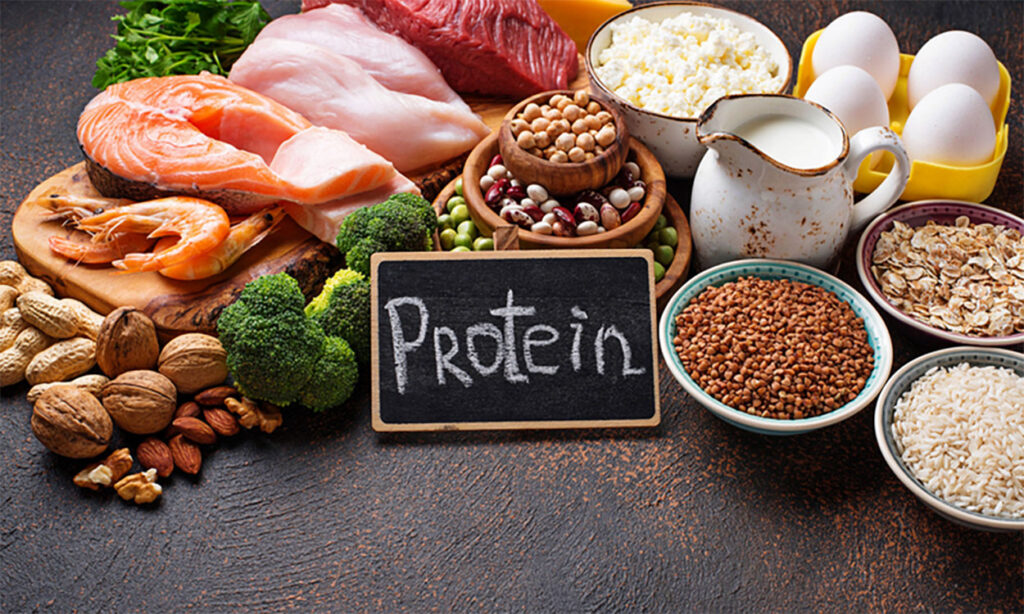Macronutrients are the essential nutrients that our bodies require in large amounts to function properly. These three giants of nutrition – carbohydrates, proteins, and fats – provide us with the energy (measured in calories) needed to fuel our daily activities, from breathing to running a marathon. They also serve as building blocks for tissues, regulate crucial bodily processes, and support overall health and well-being. Understanding the role of each macronutrient, their sources, and appropriate intake is fundamental for optimizing our diet and achieving our health goals.

I. Carbohydrates: The Body’s Primary Energy Source
Carbohydrates are often demonized in the modern diet landscape, but they are, in reality, the body’s preferred and most readily available energy source. They are organic compounds composed of carbon, hydrogen, and oxygen, primarily found in plant-based foods. When we consume carbohydrates, our bodies break them down into glucose, a simple sugar that is transported through the bloodstream to provide energy to cells. Any excess glucose is stored as glycogen in the liver and muscles for later use. When glycogen stores are full, the body can convert excess glucose into fat for long-term energy storage.
A. Types of Carbohydrates:
Carbohydrates are categorized into two main groups: simple and complex. The classification depends on the number of sugar molecules they contain and how quickly they are digested and absorbed.
- Simple Carbohydrates (Simple Sugars): These consist of one or two sugar molecules. They are quickly digested, leading to a rapid rise in blood glucose levels. Simple carbohydrates can be further divided into:
- Monosaccharides: Single sugar units like glucose (dextrose), fructose (fruit sugar), and galactose.
- Disaccharides: Two sugar units linked together, such as sucrose (table sugar – glucose + fructose), lactose (milk sugar – glucose + galactose), and maltose (glucose + glucose).
- Complex Carbohydrates: These consist of longer chains of sugar molecules, taking longer to digest and providing a more sustained release of energy. They are generally nutrient-dense and beneficial for health. Complex carbohydrates include:
- Starches: Polysaccharides made up of many glucose units linked together. They are found in foods like potatoes, rice, corn, bread, pasta, and legumes.
- Fiber: A type of complex carbohydrate that the body cannot digest. It plays a crucial role in digestive health, blood sugar regulation, and cholesterol management. Fiber is abundant in whole grains, fruits, vegetables, legumes, and nuts.
B. The Importance of Fiber:
Fiber is a crucial component of a healthy carbohydrate intake. It exists in two main forms:
- Soluble Fiber: Dissolves in water to form a gel-like substance. It helps lower cholesterol, stabilize blood sugar levels, and promote feelings of fullness. Sources include oats, beans, apples, citrus fruits, and carrots.
- Insoluble Fiber: Does not dissolve in water. It adds bulk to the stool, promotes regular bowel movements, and prevents constipation. Sources include whole wheat products, vegetables, and wheat bran.
C. Recommended Carbohydrate Intake:
The recommended daily carbohydrate intake varies depending on individual factors such as activity level, health conditions, and dietary goals. However, a general guideline is to aim for 45-65% of your total daily calories from carbohydrates. Prioritize complex carbohydrates from whole, unprocessed sources over simple sugars. Pay close attention to the fiber content of your carbohydrate choices.
D. The Glycemic Index and Glycemic Load:
The Glycemic Index (GI) measures how quickly a food raises blood glucose levels. Foods with a high GI are rapidly digested and absorbed, leading to a sharp spike in blood sugar. Foods with a low GI are digested more slowly, resulting in a more gradual increase in blood sugar.
The Glycemic Load (GL) takes into account both the GI of a food and the amount of carbohydrates it contains in a typical serving. It provides a more comprehensive picture of a food’s impact on blood sugar levels.
Choosing foods with a low GI and GL can help stabilize blood sugar, improve insulin sensitivity, and promote weight management.

II. Proteins: The Building Blocks of Life
Proteins are essential for building, repairing, and maintaining body tissues. They are composed of amino acids, the building blocks of protein. Our bodies can synthesize some amino acids (non-essential amino acids), while others must be obtained from our diet (essential amino acids). Proteins are involved in a wide range of crucial functions, including:
- Structural Support: Proteins form the framework of muscles, bones, skin, hair, and nails.
- Enzymes: Proteins act as enzymes, catalyzing biochemical reactions that are essential for life.
- Hormones: Many hormones are proteins, regulating bodily processes like metabolism, growth, and reproduction.
- Antibodies: Proteins form antibodies that help fight off infections and diseases.
- Transport: Proteins transport nutrients, oxygen, and other substances throughout the body.
A. Types of Proteins:
Proteins are classified based on their amino acid composition:
- Complete Proteins: Contain all nine essential amino acids in adequate amounts. They are typically found in animal-based foods like meat, poultry, fish, eggs, and dairy products.
- Incomplete Proteins: Lack one or more essential amino acids. They are primarily found in plant-based foods like legumes, grains, nuts, and seeds. By combining different incomplete protein sources (e.g., beans and rice), you can obtain all the essential amino acids.
B. Recommended Protein Intake:
The recommended daily protein intake varies depending on factors such as age, activity level, muscle mass, and overall health. The Recommended Dietary Allowance (RDA) for protein is 0.8 grams per kilogram of body weight per day. However, individuals who are physically active, pregnant, or recovering from illness may require higher protein intakes. Athletes, for example, may need 1.2-2.0 grams of protein per kilogram of body weight per day.
C. Protein Sources:
Excellent sources of protein include:
- Animal Sources: Lean meats (chicken, turkey, beef), fish (salmon, tuna, cod), eggs, dairy products (milk, yogurt, cheese).
- Plant Sources: Legumes (beans, lentils, chickpeas), tofu, tempeh, edamame, nuts, seeds, quinoa.
D. The Importance of Protein Quality:
When choosing protein sources, consider both the quantity and the quality of the protein. Prioritize lean protein sources and incorporate a variety of both animal and plant-based proteins into your diet.

III. Fats: Essential for Hormone Production and Nutrient Absorption
Fats, also known as lipids, are essential for various bodily functions, including hormone production, nutrient absorption, insulation, and energy storage. While often feared, fats are vital for maintaining overall health. They are the most energy-dense macronutrient, providing 9 calories per gram, compared to 4 calories per gram for carbohydrates and proteins.
A. Types of Fats:
Fats are classified into several categories based on their chemical structure:
- Saturated Fats: Have no double bonds in their fatty acid chains. They are typically solid at room temperature and are found primarily in animal products like red meat, butter, cheese, and coconut oil. Excessive consumption of saturated fats has been linked to increased LDL cholesterol levels, which can increase the risk of heart disease. Current dietary guidelines recommend limiting saturated fat intake to less than 10% of total daily calories.
- Unsaturated Fats: Have one or more double bonds in their fatty acid chains. They are typically liquid at room temperature and are found in plant-based foods like olive oil, avocados, nuts, and seeds. Unsaturated fats are further divided into:
- Monounsaturated Fats (MUFAs): Have one double bond. They are found in olive oil, avocados, nuts, and seeds. MUFAs can help lower LDL cholesterol levels and improve heart health.
- Polyunsaturated Fats (PUFAs): Have two or more double bonds. They are found in vegetable oils (sunflower, corn, soybean), fatty fish (salmon, tuna, mackerel), and nuts and seeds. PUFAs are essential fats, meaning our bodies cannot produce them and we must obtain them from our diet. They include omega-3 and omega-6 fatty acids.
- Omega-3 Fatty Acids: Essential for brain health, heart health, and reducing inflammation. They are found in fatty fish, flaxseeds, chia seeds, and walnuts.
- Omega-6 Fatty Acids: Essential for growth and development. They are found in vegetable oils, nuts, and seeds. It’s important to maintain a healthy balance between omega-3 and omega-6 fatty acids in the diet.
- Trans Fats: Unsaturated fats that have been artificially hydrogenated to increase their shelf life and stability. They are found in processed foods like fried foods, baked goods, and margarine. Trans fats have been shown to raise LDL cholesterol levels and lower HDL cholesterol levels, significantly increasing the risk of heart disease. Trans fats should be avoided as much as possible.
B. Recommended Fat Intake:
The recommended daily fat intake is typically 20-35% of total daily calories. Prioritize unsaturated fats from sources like olive oil, avocados, nuts, seeds, and fatty fish. Limit saturated fat intake and avoid trans fats altogether.
C. The Role of Cholesterol:
Cholesterol is a waxy substance that is found in all cells of the body. It is essential for hormone production, cell membrane structure, and vitamin D synthesis. Cholesterol is transported in the blood by lipoproteins:
- Low-Density Lipoprotein (LDL): Often referred to as “bad” cholesterol. High levels of LDL cholesterol can contribute to the buildup of plaque in the arteries, increasing the risk of heart disease.
- High-Density Lipoprotein (HDL): Often referred to as “good” cholesterol. HDL cholesterol helps remove LDL cholesterol from the arteries, reducing the risk of heart disease.
While dietary cholesterol does have a relatively small impact on blood cholesterol levels for most people, saturated and trans fats have a much more significant effect.

IV. Macronutrient Ratios and Individual Needs
The ideal macronutrient ratio (the percentage of total calories from each macronutrient) varies depending on individual factors, including:
- Activity Level: Athletes and individuals who are physically active may require higher carbohydrate and protein intakes to fuel their activities and support muscle growth and repair.
- Health Goals: Individuals trying to lose weight may benefit from a higher protein and lower carbohydrate intake. Individuals with diabetes need to manage their carbohydrate intake carefully to maintain stable blood sugar levels.
- Health Conditions: Certain health conditions may require specific macronutrient adjustments.
Experimenting with different macronutrient ratios and monitoring how your body responds can help you find the optimal balance for your individual needs.

V. The Importance of Whole Foods:
Regardless of the specific macronutrient ratio you choose, it is crucial to prioritize whole, unprocessed foods over refined and processed foods. Whole foods are naturally nutrient-dense and provide a wide range of vitamins, minerals, and antioxidants. They are also more filling and satisfying, which can help with weight management and overall health.
VI. Consulting a Healthcare Professional:
It’s always recommended to consult with a registered dietitian or other qualified healthcare professional for personalized dietary advice. They can help you assess your individual needs, develop a meal plan that is tailored to your goals, and address any specific health concerns you may have.
Conclusion:
Macronutrients are the cornerstones of a healthy diet, providing energy, building blocks, and regulatory support for our bodies. Understanding the role of carbohydrates, proteins, and fats, their different types, and appropriate intake is essential for optimizing our health and well-being. By prioritizing whole foods, choosing nutrient-dense options, and adjusting macronutrient ratios to meet individual needs, we can fuel our bodies effectively and achieve our health goals. Remember to consult with a healthcare professional for personalized dietary guidance.